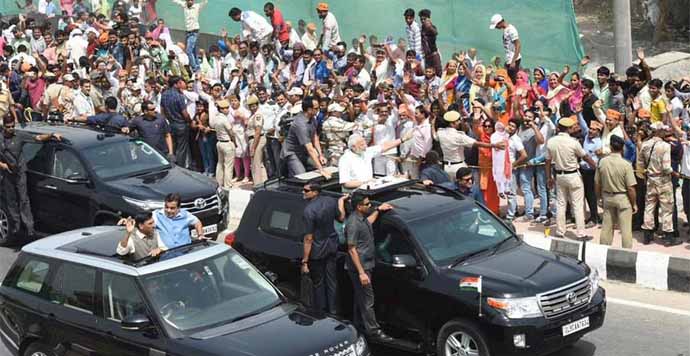Is Delhi-Meerut Expressway cracking under the strain of 'vikas'?

Road infrastructure, as they say, is the lifeline of any economy, and, like everything else, it has a life span. The problem in India is that this span is way too short.
The Delhi-Meerut expressway, which was inaugurated by Prime Minister Narendra Modi in May, is already showing cracks with the first spell of pre-monsoon showers. According to a report in ABP, an entire portion of the road has caved in.
The same report said initially a crack appeared on one side and then, a portion of the road caved in. Engineers working on the reconstruction of the damaged portion, the report claimed, blamed water trickling in from the drains for the caving-in of the road.
Newly inaugurated Delhi-Meerut expressway damaged after first spell of showershttps://t.co/UVt0fVPqME
— ABP News (@abpnewstv) June 29, 2018
While the ugly cracks have exposed the chinks in the government's development agenda, more such cracks can invite major tragedy on the expressway, which has been touted to be the "road to freedom from pollution".
Built on a budget of Rs 7,500-crore, the 14-lane Delhi-Meerut Expressway on its completion is expected to cut down the travel time between the two cities to 40 minutes from the current two-and-half-hours.
Jazzy roadshows and all that jazz
Although the entire stretch is yet to be functional, the Delhi-Meerut Expressway has been making headlines after PM Modi inaugurated a 9km stretch of this in a extravagant road show on May 27. The timing of the blitzkrieg, however, had raised many eyebrows — completion of four years of the NDA government and just two days ahead of the high-stakes Kairana bypoll, which the BJP lost eventually. It became a major talking point for the Opposition because nearly 90 per cent of the 82-km project is yet to be made operational.


According to this report, PM Modi only "inaugurated phase 1 (worth Rs 841 crore) of the Rs 7,500 crore project, a mere 8.36-km stretch within the borders of Delhi from Nizamuddin Bridge to the Delhi-Uttar Pradesh border. Beyond that, commuters to Meerut from Delhi have to continue on the congested four-lane National Highway 34". Interestingly, only 31 per cent of the 82-km expressway has been constructed to date, according to RP Singh, project director at the National Highways Authority of India (NHAI).
At the time of inauguration the PM had also claimed that the first phase had been completed in "record-time" of 18 months.
Speed thrills — and kills too
India has awarded road contracts at a "breakneck pace” in 2018. In the financial year 2017-18, the NHAI has awarded 150 road projects of 7,400 km worth Rs 1,22,000 crore. In past five years, the government claims, the average length of road projects awarded by NHAI was 2,860km with 4,335km awarded in the last financial year. In comparison, the length of projects awarded in FY 2017-18 is an all-time high and a record achievement by NHAI since its inception in 1995.
Political observers say the Modi government’s record on meeting his government’s infrastructure targets and on job creation will prove crucial ahead of the 2019 general election to highlight its economic credentials.
Bragging credentials
To show highway construction in a better light, the government earlier announced it would adopt global norms — lane length kilometre formula — for calculating highways construction from this fiscal. The ministry so far had been calculating construction of National Highways in linear length, which means there is no difference between 1km of two-lane with paved shoulders and 1km with six-lanes and service roads, according to Union road, transport, highways minister Nitin Gadkari.
The decision came after India hit a record 26.92km road building per day in FY2017-18, which, as per international standards, is 94.18 lane km.
"World over, the road construction is calculated as per this formula," Gadkari had said.
According to an official statement released recently, the length of projects awarded in 2017-18 is at an all-time high and a record achievement by NHAI since its inception in 1995. The new formula, experts believe, will help give a better picture of road construction in the country on an yearly basis.
My way or no highway
But, of all the mistakes made by an emerging India, the drive for fast-track development has to be one of the most reckless. Successive governments have single-mindedly believed that building more and more roads, or at least announcing them will also pave the way for more votes, if not development. And it perhaps does.
While roads are considered necessary for progress, the Indian voters for whom all these roads are supposedly built, are instead left to negotiate giant potholes, waterlogged lanes, insane and unmanaged traffic and, of course, deadly accidents.
According to the Road Accidents Report of 2016 published by the transport research wing of the transport ministry, as many as 2,983 people died in that year because of bad road condition, while 529 lives were lost because of engineering and design fault, and 2,823 died because of the vehicle’s fault.
Back in May, PM Modi after his roadshow had said: "The modern infrastructure of the country has a very important role in improving lives of all the 1.25 crore people of the country. With this, everyone is on the path of development, because infrastructure does not distinguish between caste, creed, community, rich and poor."
While such "commitment" to development and inclusiveness has every potential to sweep voters off their feet, the reality behind such promises — sadly, as the Delhi-Meerut Expressway shows — also exposes the gaping holes.

